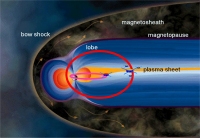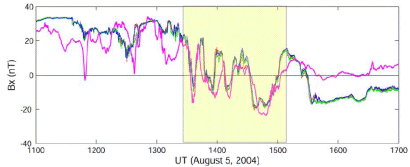Cluster and Double Star reveal the extent of neutral sheet oscillations
30 March 2006
For the first time, neutral sheet oscillations observed simultaneously at tens of thousands kilometres distance are reported, thanks to observations by 5 satellites of the Cluster and the Double Star Program missions. Published 8 November 2005 in Annales Geophysicae, this new observational first provides further constraint to model this large-scale phenomenon in the magnetotail.
Rapid large-amplitude magnetic variations (Image 2) are frequently observed in the centre of the magnetotail. These variations indicate up and down (north-south) oscillating neutral sheet motions, known as current sheet flapping motions. Two possible origins of these motions have been proposed in the past: external (inhomogeneous solar wind) or internal (large–scale wave, emitted in the neutral sheet and/or propagating in the tail).
Before Cluster, no final conclusion could be drawn, due to the difficulties of separating spatial and temporal effects. In 2004, a systematic analysis of tens of rapid plasma sheet crossings, observed by the four Cluster spacecraft, suggested that the flapping motions are of internal origin. Waves, called kink-like waves, are emitted in the centre of the tail and propagate toward the tail flanks (see also "Cluster discovers internal origin of the plasma sheet oscillations").
Previous studies suggested that geomagnetic substorms play some role in the excitations of these flapping waves. However, the concrete mechanisms which destabilize the magnetotail current sheet in the substorm process and launch these kink waves are yet to be identified. Therefore, new geophysical properties of these oscillations (e.g. their extent in the magnetotail) are needed to further constrain theoretical models and numerical simulations.
A new property has been recently found, thanks to the magnetic field measurements by 5 satellites of the Cluster and the Double Star Program missions. On 5 August 2004, neutral sheet oscillations of kink-like wave type were observed at distances of both 11 RE by the TC-1 Double Star spacecraft and 16 RE by the 4 Cluster spacecraft (1 RE = Earth radius, 6378 km). In other words, the same neutral sheet oscillations have been observed at more than 30 000 km distance (Image 3).
This is an observational first as no simultaneous observations of this phenomenon at two different magnetotail locations have been made to date. Moreover, no presence of neutral sheet kink-like waves has been found in the magnetotail at a distance below 14 RE, only between ~14 RE and 30 RE. TC-1 itself has therefore showed that these oscillations occur as close as 11 RE, in the vicinity of the region where the magnetotail neutral sheet connects to the geomagnetic dipole.
 |
| Image 3 Artistic view of the neutral sheet oscillations observed in the magnetotail by the four Cluster spacecraft (in blue) and the Double Star TC-1 spacecraft in red. (Credit: ESA) |
"Coordinated observations between the 6 satellites composing the Cluster and the Double Star Program missions enable to achieve multi-point and multi-scale measurements in key regions of the magnetosphere. This scientific breakthrough is a good example of how these coordinated observations can be used to derive new properties of large-scale phenomenon of significant geophysical importance in the magnetotail", says Philippe Escoubet, Cluster and Double Star project scientist of the European Space Agency.
Zhang, T. L., R. Nakamura, M. Volwerk, A. Runov, W. Baumjohann, H. U. Eichelberger, C. Carr, A. Balogh, V. Sergeev, J. K. Shi, K.-H. Fornacon, Double Star/Cluster Observations of Neutral Sheet Oscillations on 5 August 2004, Annales Geophysicae, 23, 2909–2914, 2005.
Contact
Tielong Zhang, Austrian Academy of Sciences, Institut für Weltraumforschung, Schmiedlstraße 6, 8042 Graz, Austria
Telephone: +43-316-4120-552
Email: tielong.zhang oeaw.ac.at
oeaw.ac.at
Web story author and co-editor
Arnaud Masson, Research and Scientific Support Department, ESA, The Netherlands
Telephone: +31-71-565-5634
Email: Arnaud.Masson esa.int
esa.int
Web story editor
Philippe Escoubet, Research and Scientific Support Department, ESA, The Netherlands
Telephone: +31-71-565-3454
Email: Philippe.Escoubet esa.int
esa.int



